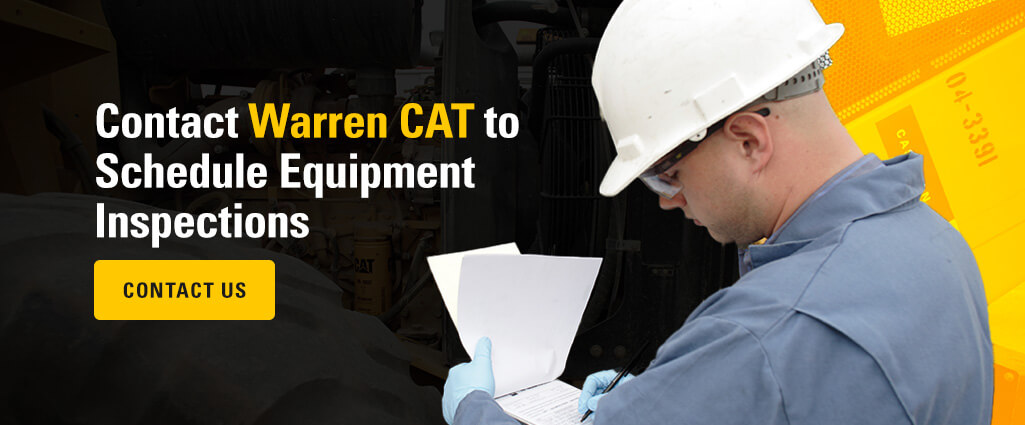Equipment Inspections From Warren CAT
Keeping up with your Cat® equipment maintenance is key to ensuring its long-term reliability, performance and value. Regular preventative maintenance helps you mitigate equipment problems and catch potential issues before they impact performance or cause serious damage.
Call our service division at 866-594-0534 or contact us online to get started.
At Warren CAT, we follow the standard inspection protocols for all of your Cat equipment, and we recommend you do the same. This means nothing will be overlooked, and you can easily see if anything has changed from one inspection to the next. Using a systematic approach is how our service experts guarantee consistent, reliable equipment inspections and plan the necessary maintenance and repairs to keep your equipment running properly.
Why Prioritize Heavy Equipment Inspection and Maintenance?
Regular service can prevent unscheduled equipment downtime and improve your fleet’s productivity. The proper maintenance can help you navigate the uncertainties of supply chain crises and other common issues that can extend downtime for repair and part lead times.
Properly maintaining your equipment increases longevity, fuel efficiency and performance. Depending on your working conditions and application, certain components may wear down more quickly and require frequent inspections to keep running as it should.
Even common issues from regular use can lead to more expensive operation, reduced performance and shorter serviceable life. For example, fluids and filters need periodic replacement. Coolant becomes acidic over time, whereas oil breaks down, losing its effectiveness in lubricating engine components. Similarly, fuel filters and water separators ensure your engine has the fluids it requires without harmful clogs or moisture. Keeping these systems and parts in good condition ensures efficient, reliable output.
Checking your heavy equipment and machinery before use is an excellent way to ensure it functions correctly between service visits. These inspections can also help you keep operators and other employees safe. Fortunately, Cat offers resources to help your team complete thorough, documented inspections and to stay on top of your fleet’s maintenance.
Cat Inspect Mobile App
Caterpillar has developed the Cat Inspect mobile app for customers to be able to walk through the steps of a Cat equipment inspection and track changes, add notes and create reports. Learn more about the Cat Inspect mobile app, available for Apple iOS and Google Android.
Simplifying Equipment Inspections
Every piece of Cat equipment has a unique set of systems, parts and features that require individual attention. Instead of creating one “catch-all” inspection checklist, Cat has devised a unique checklist that caters to the specifics of each machine. This allows you to be thorough as you inspect your equipment and ensure you verify every critical feature, including some that you might not consider or remember to check on a regular basis.
For example, the Cat inspection checklist for backhoe loaders includes 60 points of inspection. Divided into four groups, they cover all areas of the loader and explain how to go about performing the various inspections: From the Ground, On the Machine, Engine Compartment and Inside the Cab. Thanks to the clear, straightforward descriptions on the checklist, it’s fast and easy to perform equipment inspections before every use.
As with all equipment, doing regular inspections of major functions and components only takes a few minutes, but means you can quickly see if anything needs attention. Some examples of points to check include:
- Damage and cracks to the frame, cab, steps or other frame and body components
- Fluid levels and absence of leaks for hydraulic fluid, engine oil, radiator coolant, etc.
- The state of linkages, pivot points, PTOs and other moving components that could come loose
- Hoses, belts, wiring and other under-hood components that could cause equipment failure
- Seatbelts, lights, horns, windows or other safety and visibility-related features
The checklist is also handy for training new operators and technicians so everyone is performing the same type of inspection, every time.
Your Partner for Equipment Inspections and Service
While performing inspections before using your machinery is essential, scheduling regular maintenance with a trusted dealer is the best way to keep your equipment in good condition. The Warren CAT team understands that your machinery is critical to your operations. We support your team’s productivity with preventative maintenance checks, as well as rebuilds, repairs and part replacements. Our capabilities include a vast range of service and repair options in the field and at our shops, making us the single source for Cat equipment inspections, maintenance and repair.
As an authorized Cat dealer, we have access to the region’s largest inventory of genuine Cat parts to ensure the shortest possible lead times for quality parts, components and repairs.
We strive to offer services and support that add value to your operations. Warren CAT provides customer value agreements (CVAs) to ensure you have access to the equipment inspections, maintenance and repairs you need to maximize uptime and return on investment.
Contact Warren CAT to Schedule Equipment Inspections
Warren CAT is the exclusive Cat dealer serving Oklahoma, West Texas and the Texas Panhandle. Whether your equipment requires an inspection for planned maintenance or we find components that need repair or replacement, our highly trained technicians can perform efficient, quality service.
Contact us today for a consultation!
__________________________________________________________________________________________

